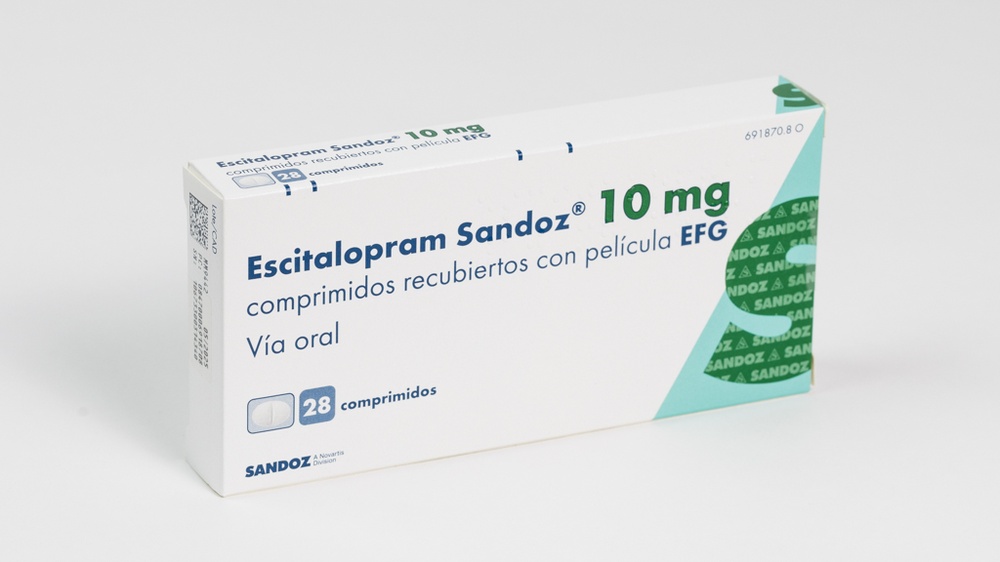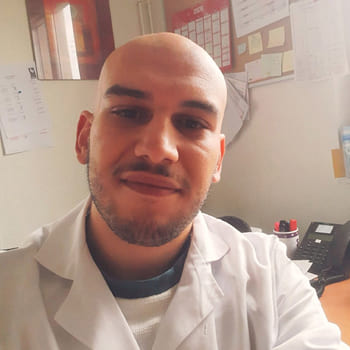

ESCITALOPRAM SANDOZ 10 mg COMPRIMIDOS REVESTIDOS POR PELÍCULA

Pergunte a um médico sobre a prescrição de ESCITALOPRAM SANDOZ 10 mg COMPRIMIDOS REVESTIDOS POR PELÍCULA

Como usar ESCITALOPRAM SANDOZ 10 mg COMPRIMIDOS REVESTIDOS POR PELÍCULA
Introdução
Prospecto: informação para o paciente
Escitalopram Sandoz 10 mg comprimidos revestidos com película EFG
Escitalopram Sandoz 15 mg comprimidos revestidos com película EFG
Escitalopram Sandoz 20 mg comprimidos revestidos com película EFG
Leia todo o prospecto detenidamente antes de começar a tomar este medicamento porque contém informações importantes para si.
- Conserva este prospecto, pois pode ter que voltar a lê-lo.
- Se tiver alguma dúvida, consulte o seu médico ou farmacêutico.
- Este medicamento foi prescrito apenas para si e não deve dá-lo a outras pessoas, mesmo que tenham os mesmos sintomas que si, pois pode prejudicá-las.
- Se experimentar efeitos adversos, consulte o seu médico ou farmacêutico, mesmo que se trate de efeitos adversos que não aparecem neste prospecto. Ver seção 4.
Conteúdo do prospecto
- O que é Escitalopram Sandoz e para que é utilizado
- O que precisa saber antes de começar a tomar Escitalopram Sandoz
- Como tomar Escitalopram Sandoz
- Possíveis efeitos adversos
- Conservação de Escitalopram Sandoz
Conteúdo do envase e informação adicional
1. O que é Escitalopram Sandoz e para que é utilizado
Escitalopram Sandoz contém o princípio ativo escitalopram. Escitalopram pertence a um grupo de antidepressivos denominados inibidores seletivos da recaptação de serotonina (ISRSs). Estes medicamentos atuam sobre o sistema serotoninérgico no cérebro aumentando o nível de serotonina. As alterações do sistema serotoninérgico são consideradas um fator importante no desenvolvimento da depressão e doenças relacionadas.
Escitalopram está indicado para o tratamento da depressão(episódios depressivos maiores) e transtornos de ansiedade(tais como transtorno de angústia com ou sem agorafobia, transtorno de ansiedade social, transtorno de ansiedade generalizada e transtorno obsessivo-compulsivo).
Podem passar um par de semanas antes de que comece a se sentir melhor. Continue tomando escitalopram mesmo que leve um tempo para notar alguma melhoria.
Deve consultar um médico se não melhora ou se piora.
2. O que precisa saber antes de começar a tomar Escitalopram Sandoz
Não tome Escitalopram Sandoz:
- se é alérgico ao escitalopram ou a algum dos outros componentes deste medicamento (incluídos na seção 6),
- se toma outros medicamentos que pertencem ao grupo denominado inibidores da MAO, incluindo selegilina (utilizada para o tratamento da doença de Parkinson), moclobemida (utilizada para o tratamento da depressão) e linezolid (um antibiótico),
- se padece de nascimento ou sofreu um episódio de alteração da frequência cardíaca (detectado em um ECG, prova que avalia o funcionamento do coração),
- se está tomando medicamentos para problemas de ritmo cardíaco ou que possam afetar o ritmo cardíaco (ver seção 2 “Outros medicamentos e Escitalopram Sandoz”).
Advertências e precauções
Consulte o seu médico ou farmacêutico antes de começar a tomar Escitalopram Sandoz. Informe ao seu médico se padece algum outro transtorno ou doença, pois o seu médico pode precisar ter isso em conta. Em concreto, informe ao seu médico se:
- padece epilepsia. O tratamento com escitalopram deve ser interrompido se se produzirem convulsões pela primeira vez ou se observa um incremento na frequência das convulsões (ver também seção 4 “Possíveis efeitos adversos”),
- tem problemas com ofuncionamento do seu fígadoou rim. Pode que o seu médico precise ajustar-lhe a dosagem,
- padece diabetes. O tratamento com escitalopram pode alterar o controle glicêmico. Pode ser necessário um ajuste da dosagem de insulina e/ou hipoglicemiante oral,
- tem um nível diminuído de sódiono sangue,
- tem tendência a desenvolver hemorragiasou cardenais, ou se está grávida (ver “Gravidez”),
- está recebendo tratamento eletroconvulsivo,
- padece uma doença coronária,
- padece ou já padecia problemas de coração ou sofreu recentemente um ataque cardíaco,
- o ritmo do seu coração em repouso é lento e/ou sabe que pode ter uma diminuição de sal como resultado de uma diarreia grave e prolongada e vômitos (estando doente) ou uso de diuréticos,
- experimenta batimentos cardíacos rápidos ou irregulares, desfalecimento, colapso ou tontura ao levantar-se, que pode ser indicativo de um funcionamento anômalo do ritmo do coração,
- tem ou já teve anteriormente problemas de olhos, como certos tipos de glaucoma (incremento da tensão no olho).
Tenha em conta
Alguns pacientes com doença maníaco-depressivapodem entrar em uma fase maníaca. Isso se caracteriza por um cambio de ideias pouco comum e rápido, alegria desproporcionada e uma atividade física excessiva. Se você o experimenta, contacte com o seu médico.
Sintomas como inquietude ou dificuldade para sentar-se ou estar de pé, podem ocorrer também durante as primeiras semanas de tratamento. Informe ao seu médico imediatamente se experimenta estes sintomas.
Alguns medicamentos do grupo ao qual pertence Escitalopram Sandoz (chamados ISRS/IRSN) podem causar sintomas de disfunção sexual (ver seção 4). Em alguns casos, estes sintomas persistem após a suspensão do tratamento.
Pensamentos suicidas e piora da depressão ou transtorno de ansiedade
Se se encontra deprimido e/ou sofre um transtorno de ansiedade, pode que em algumas ocasiões tenha pensamentos de se machucar ou de suicídio. Estes podem ir aumentando ao tomar antidepressivos pela primeira vez, posto que todos estes medicamentos requerem um tempo para começar a fazer efeito, geralmente ao redor de umas duas semanas, embora em alguns casos possa ser maior o tempo.
Pode ser mais propenso a ter este tipo de pensamentos:
- se previamente teve pensamentos de suicídio ou autolesão,
- se é um adulto jovem. Informação de ensaios clínicos demonstrou um aumento do risco de condutas suicidas em adultos menores de 25 anos com doenças psiquiátricas que foram tratados com um antidepressivo.
Se em qualquer momento tiver pensamentos de autolesionar-se ou de suicídio, contacte com o seu médico ou dirija-se diretamente a um hospital.
Pode ajudá-lo dizer a um parente ou um amigo próximoque está deprimido ou que tem um transtorno de ansiedade e pedir-lhe que leia este prospecto. Pode perguntar-lhes se pensam que a sua depressão ou transtorno de ansiedade piorou. Ou se estão preocupados com as mudanças na sua atitude.
Crianças e adolescentes
Escitalopram não deve ser utilizado normalmente no tratamento de crianças e adolescentes menores de 18 anos. Assim como, deve saber que em pacientes menores de 18 anos existe um maior risco de efeitos adversos como tentativas de suicídio, ideias de suicídio e hostilidade (predominantemente agressão, comportamento de confrontação e irritação) quando ingerem esta classe de medicamentos. Pese a isso, o seu médico pode prescrever escitalopram a pacientes menores de 18 anos quando decidir o que é mais conveniente para o paciente. Se o seu médico prescreveu escitalopram a um paciente menor de 18 anos e deseja discutir esta decisão, por favor, volte ao seu médico. Deve informar ao seu médico se algum dos sintomas descritos anteriormente progride ou experimenta complicações quando pacientes menores de 18 anos estão tomando escitalopram. Além disso, os efeitos a longo prazo em relação à segurança, no crescimento, maturidade e desenvolvimento cognitivo e comportamental de escitalopram neste grupo de idade não foram demonstrados ainda.
Outros medicamentos e Escitalopram Sandoz
Informe ao seu médico ou farmacêutico se está tomando, tomou recentemente ou pudesse ter que tomar, qualquer outro medicamento.
Informe ao seu médico se está tomando algum dos seguintes medicamentos:
- Inibidores não seletivos da monoaminooxidase (IMAOs), que contenham fenelzina, iproniazida, isocarboxazida, nialamida e tranilcipromina como princípios ativos. Se tomou algum destes medicamentos, tem que esperar 14 dias antes de começar a tomar escitalopram. Depois de terminar com escitalopram, devem transcorrer 7 dias antes de tomar algum destes medicamentos.
- Inibidores seletivos da MAO-A reversíveis, que contenham moclobemida (utilizados no tratamento da depressão).
- Inibidores da MAO-B irreversíveis, que contenham selegilina (utilizado no tratamento da doença de Parkinson). Estes incrementam o risco de efeitos secundários.
- O antibiótico linezolid.
- Lítio(utilizado no tratamento do transtorno maníaco-depressivo) e triptófano.
- Imipramina e desipramina(ambos utilizados no tratamento da depressão).
- Sumatriptano e medicamentos semelhantes(utilizados para o tratamento da enxaqueca), tramadol(utilizado contra a dor intensa). Estes aumentam o risco de efeitos secundários.
- Buprenorfina(utilizada para a dor intensa) pois incrementa o risco de síndrome serotoninérgico, um síndrome potencialmente mortal.
- Cimetidina, lansoprazol e omeprazol(utilizados para o tratamento das úlceras de estômago), fluconazol(utilizado para tratar infecções por fungos), fluvoxamina(antidepressivo) e ticlopidina(utilizados para reduzir o risco de acidente cerebro-vascular). Estes podem causar aumento das concentrações no sangue de escitalopram.
- Erva de São João(Hypericum perforatum) – planta medicinal utilizada para a depressão.
- Ácido acetilsalicílico e medicamentos antiinflamatórios não esteroideos (AINEs)(medicamentos utilizados para aliviar a dor ou para reduzir o risco de trombose, também chamados anticoagulantes). Estes podem aumentar a tendência a hemorragias.
- Varfarina, dipiridamole fenprocumona(medicamentos utilizados para fluidificar o sangue, também chamados anticoagulantes). O seu médico controlará provavelmente o tempo de coagulação do sangue no início e no final do tratamento com escitalopram, para comprovar que a dosagem de anticoagulante é ainda adequada.
- Mefloquina(utilizada para o tratamento da malária), bupropião(usado para o tratamento da depressão) e tramadol(utilizado para o tratamento da dor intensa) devido ao possível risco de diminuir o limiar de convulsões.
- Neurolépticos(medicamentos utilizados para o tratamento da esquizofrenia, psicose) e antidepressivos (antidepressivos tricíclicos e ISRSs) devido ao possível risco de diminuir o limiar de convulsões.
- Flecainida, propafenona e metoprolol(utilizados em doenças cardiovasculares), clomipramina e nortriptilina(antidepressivos) e risperidona, tioridazina e haloperidol(antipsicóticos). Pode ser que a dosagem de escitalopram precise ser ajustada.
- Medicamentos que diminuem os níveis de potássio ou magnésio no sangue, pois isso incrementa o risco de sofrer alterações do ritmo do coração, que supõem um risco para a vida.
Não tome escitalopram se está tomando medicamentos para problemas do ritmo cardíaco ou que possam afetar o ritmo cardíaco, p. ex. antiarrítmicos Classe IA e III, antiarritmicos, antipsicóticos (p. ex. derivados de fenotiazina, pimozida, haloperidol), antidepressivos tricíclicos, alguns agentes antimicrobianos (p. ex. esparfloxacino, moxifloxacino, eritromicina IV, pentamidina, tratamento antimalárico particularmente halofantrina), alguns antihistamínicos (astemizol, hidroxicina, mizolastina). Contacte com o seu médico para qualquer consulta adicional.
Toma de Escitalopram Sandoz com alimentos, bebidas e álcool
Escitalopram Sandoz pode ser tomado com ou sem alimentos (ver seção 3 “Como tomar Escitalopram Sandoz”).
Como com muitos medicamentos, não se recomenda a combinação de Escitalopram Sandoz e álcool, embora não se espere que Escitalopram Sandoz interaja com álcool.
Gravidez, lactação e fertilidade
Se está grávida ou em período de lactação, acredita que possa estar grávida ou tem intenção de ficar grávida, consulte o seu médico ou farmacêutico antes de utilizar este medicamento. Não tome escitalopram se está grávida ou em período de lactação a menos que você e o seu médico tenham analisado os riscos e benefícios implicados.
Se tomar escitalopram durante os últimos 3 meses da gravidez, tem que ser consciente de que se podem observar no bebê recém-nascido os seguintes efeitos: dificuldade respiratória, pele azulada, ataques, mudanças da temperatura corporal, dificuldades para se alimentar, vômitos, açúcar baixo no sangue, rigidez ou flacidez muscular, reflexos intensos, tremores, inquietude, irritabilidade, letargia, choro constante, sonolência e dificuldades para dormir. Se o seu bebê recém-nascido tem algum destes sintomas, contacte com o seu médico imediatamente.
Certifique-se de que a sua parteira e/ou médico sabem que está sendo tratado com escitalopram.
Durante a gravidez, particularmente nos últimos 3 meses, medicamentos como escitalopram podem aumentar o risco de uma doença grave em recém-nascidos, denominada hipertensão pulmonar persistente neonatal (HPPN), na qual o bebê respira rapidamente e se põe azulado. Estes sintomas costumam começar durante as primeiras 24 horas após o nascimento. Se aparecem no seu bebê, deve contactar com a sua parteira e/ou médico imediatamente.
Se escitalopram for utilizado durante a gravidez, nunca se deve interromper bruscamente.
É de esperar que escitalopram seja excretado através do leite materno.
Se tomar Escitalopram Sandoz na etapa final da gravidez, pode produzir-se um maior risco de sangramento vaginal abundante pouco após o parto, especialmente se tem antecedentes de alterações hemorrágicas. O seu médico ou parteira devem saber que você está tomando Escitalopram Sandoz para poder aconselhá-lo.
Citalopram, um medicamento semelhante a escitalopram, demonstrou reduzir a qualidade do esperma em modelos animais. Teoricamente, este efeito poderia afetar a fertilidade, mas até a data não se observou seu impacto na fertilidade humana.
Condução e uso de máquinas
Não conduza nem utilize máquinas até que saiba como lhe afeta o tratamento com escitalopram.
Escitalopram Sandoz contém lactose e sódio
Este medicamento contém lactose. Se o seu médico lhe indicou que padece uma intolerância a certos açúcares, consulte com ele antes de tomar este medicamento.
Este medicamento contém menos de 23 mg de sódio (1mmol) por comprimido revestido com película; isto é, essencialmente “isento de sódio”.
3. Como tomar Escitalopram Sandoz
Siga exatamente as instruções de administração deste medicamento indicadas pelo seu médico ou farmacêutico. Em caso de dúvida, consulte novamente o seu médico ou farmacêutico.
Adultos
Depressão
A dose recomendada é de 10 mg tomados como dose única ao dia. O seu médico pode aumentá-la até um máximo de 20 mg ao dia.
Transtorno de ansiedade
A dose inicial é de 5 mg como dose única ao dia durante a primeira semana antes de aumentar a dose para 10 mg ao dia. O seu médico pode aumentá-la posteriormente até um máximo de 20 mg ao dia.
Transtorno de ansiedade social
A dose recomendada é de 10 mg tomados como dose única ao dia. O seu médico pode diminuir a dose para 5 mg ao dia ou aumentá-la até um máximo de 20 mg ao dia, dependendo de como o paciente responde ao medicamento.
Transtorno de ansiedade generalizada
A dose recomendada é de 10 mg tomados como dose única ao dia. A dose pode ser aumentada pelo médico até um máximo de 20 mg ao dia.
Transtorno obsessivo-compulsivo
A dose recomendada é de 10 mg tomados como dose única ao dia. A dose pode ser aumentada pelo médico até um máximo de 20 mg ao dia.
Idade avançada (maiores de 65 anos)
A dose inicial recomendada de escitalopram é de 5 mg tomados como dose única ao dia. A dose pode ser aumentada pelo médico até 10 mg ao dia.
Uso em crianças e adolescentes (menores de 18 anos)
Escitalopram normalmente não deve ser administrado a crianças e adolescentes. Para informações adicionais, ver seção 2 “Advertências e precauções”.
Insuficiência renal
É aconselhada precaução em pacientes com função renal gravemente diminuída. Tomar conforme prescrito pelo médico.
Insuficiência hepática
Pacientes com problemas hepáticos não devem receber mais de 10 mg por dia. Tomar conforme prescrito pelo médico.
Pacientes considerados como metabolizadores lentos da CYP2C19
Pacientes com este genótipo conhecido não devem receber mais de 10 mg por dia. Tomar conforme prescrito pelo médico.
Forma de administração
Pode tomar escitalopram com ou sem comida. Engula o comprimido com um pouco de água.
Escitalopram Sandoz 10 mg:
Se necessário, pode dividir os comprimidos em duas partes iguais.
Escitalopram Sandoz 15 mg:
Se necessário, pode dividir os comprimidos em três partes iguais.
Escitalopram Sandoz 20 mg:
Se necessário, pode dividir os comprimidos em quatro partes iguais.
Duração do tratamento
- Podem passar um par de semanas antes de que comece a se sentir melhor. Continue tomando escitalopram mesmo se começar a se sentir melhor antes do previsto em sua condição.
- Não altere a dose do medicamento sem falar antes com o seu médico.
- Continue tomando escitalopram pelo tempo recomendado pelo seu médico. Se interromper o tratamento muito cedo, os sintomas podem reaparecer. É recomendado que o tratamento continue durante pelo menos 6 meses após voltar a se sentir bem.
Se tomar mais Escitalopram Sandoz do que deve
Se tomou mais Escitalopram Sandoz do que deve, consulte imediatamente o seu médico, o seu farmacêutico ou ligue para o Serviço de Informação Toxicológica, telefone: 91 562 04 20, indicando o medicamento e a quantidade utilizada. Faça-o mesmo quando não observe desconfortos ou sinais de intoxicação. Alguns dos sinais de sobredose podem ser tonturas, tremores, agitação, convulsão, coma, náuseas, vômitos, alterações no ritmo cardíaco, diminuição da pressão sanguínea e alterações no equilíbrio hidro/salino corporal. Leve o frasco de escitalopram se for ao médico ou ao hospital.
Se esquecer de tomar Escitalopram Sandoz
Não tome uma dose dupla para compensar as doses esquecidas. Se esquecer de tomar uma dose, e se lembrar antes de ir para a cama, tome-a imediatamente. No dia seguinte, siga como sempre. Se se lembrar durante a noite ou no dia seguinte, deixe a dose esquecida e siga como sempre.
Se interromper o tratamento com Escitalopram Sandoz
Não interrompa o tratamento com escitalopram até que o seu médico o diga. Quando tiver terminado o seu curso de tratamento, geralmente é recomendado que a dose de escitalopram seja reduzida gradualmente durante várias semanas.
Quando deixar de tomar escitalopram, especialmente se for de forma brusca, pode sentir sintomas de retirada. Estes são frequentes quando se suspende o tratamento com escitalopram. O risco é maior quando escitalopram é utilizado durante longo tempo, em doses elevadas ou quando a dose é reduzida muito rapidamente. A maioria das pessoas encontra que estes sintomas são leves e desaparecem por si mesmos em duas semanas. No entanto, em alguns pacientes podem ser intensos ou prolongados (2 a 3 meses ou mais). Se tiver sintomas graves de retirada quando deixar de tomar escitalopram, entre em contato com o seu médico. Ele ou ela pode pedir que volte a tomar os comprimidos novamente e os deixe mais lentamente.
Os sintomas de retirada incluem: sensação de vertigem (inestável ou sem equilíbrio), sensação de formigamento, sensação de picada e (com menos frequência) de choque elétrico, mesmo na cabeça, alterações do sono (sonhos muito intensos, pesadelos, incapacidade de dormir), sensação de inquietude, dor de cabeça, sensação de mareio (náuseas), suoração (incluindo suores noturnos), sensação de inquietude ou agitação, tremor (inestabilidade), sentimento de confusão ou desorientação, sentimentos de emoção ou irritação, diarreia (fezes soltas), alterações visuais, pulsação rápida ou palpitações.
Se tiver alguma outra dúvida sobre o uso deste medicamento, pergunte ao seu médico ou farmacêutico.
4. Possíveis efeitos adversos
Assim como todos os medicamentos, este medicamento pode produzir efeitos adversos, embora nem todas as pessoas os sofram.
Os efeitos adversos normalmente desaparecem após poucas semanas de tratamento. Seja consciente de que muitos dos efeitos podem ser sintomas da sua doença e, portanto, melhorarão quando começar a se sentir melhor.
Se tiver algum dos seguintes sintomas, deve contactar o seu médico ou ir ao hospital imediatamente:
Pouco frequentes(podem afetar até 1 de cada 100 pessoas):
- sangramentos incomuns, incluindo sangramentos gastrointestinais.
Raros(podem afetar até 1 de cada 1.000 pessoas):
- inchaço da pele, língua, lábios, faringe ou face, urticária ou tem dificuldades respiratórias ou de degluição (reação alérgica grave),
- febre elevada, agitação, confusão, tremores e contrações repentinas de músculos, podem ser sinais de uma situação pouco comum denominada síndrome serotoninérgica (ver seção 2).
Frequência não conhecida(não pode ser estimada a partir dos dados disponíveis):
- dificuldades para urinar,
- convulsões (ataques), ver também a subseção “Advertências e precauções”,
- pele amarelada e branqueamento nos olhos, são sinais de alteração da função hepática/hepatite,
- se experimenta batimentos cardíacos rápidos ou irregulares ou desfalecimento, sintomas que podem indicar uma condição de risco para a vida conhecida como Torsade de Pointes,
- pensamentos de se machucar (autolesão) ou pensamentos de suicídio, ver também a seção “Advertências e precauções”,
- inchaço repentino da mucosa da pele (angioedema).
Além do indicado anteriormente, foram notificados os seguintes efeitos adversos:
Muito frequentes(podem afetar mais de 1 de cada 10 pessoas):
- sentir-se mareado (náuseas),
- dor de cabeça.
Frequentes(podem afetar até 1 de cada 10 pessoas):
- entupimento ou mucosidade nasal (sinusite),
- diminuição ou aumento do apetite,
- ansiedade, agitação, sonhos estranhos, dificuldade para conciliar o sono, sentir-se dormido, mareios, bocejos, tremores, coceira na pele,
- diarreia, constipação, vômitos, secura da boca,
- aumento da sudorese,
- dores musculares e articulares (artralgia e mialgia),
- alterações sexuais (atraso da ejaculação, problemas com a ereção, diminuição da conduta sexual e as mulheres podem experimentar dificuldades para alcançar o orgasmo),
- fadiga, febre,
- aumento de peso.
Pouco frequentes(podem afetar até 1 de cada 100 pessoas):
- urticária, erupção cutânea, coceira (prurito),
- rangido de dentes, agitação, nervosismo, crises de ansiedade, confusão,
- alterações do sono, alterações do gosto, desmaios (síncope),
- dilatação da pupila (midriase), alteração visual, zumbidos nos ouvidos (tinnitus),
- perda de cabelo,
- hemorragia menstrual excessiva,
- período menstrual irregular,
- diminuição de peso,
- ritmo cardíaco rápido,
- inchaço de braços e pernas,
- hemorragia nasal.
Raros(podem afetar até 1 de cada 1.000 pessoas):
- agressividade, despersonalização, alucinações,
- ritmo cardíaco baixo.
Frequência não conhecida(não pode ser estimada a partir dos dados disponíveis):
- diminuição dos níveis de sódio no sangue (os sintomas são sentir-se mareado e mal-estar com fraqueza muscular ou confusão),
- mareios ao se levantar devido à pressão sanguínea baixa (hipotensão ortostática),
- testes de função hepática alterados (aumento das enzimas hepáticas no sangue),
- transtornos do movimento (movimentos involuntários dos músculos),
- ereções dolorosas (priapismo),
- sinais de aumento do sangramento, por exemplo, da pele ou mucosas (equimose),
- inchaço repentino da pele ou mucosas (angioedema),
- aumento da secreção da hormona ADH, que provoca a retenção de água no corpo e diluição do sangue, reduzindo a quantidade de sódio (secreção inapropriada de ADH),
- produção de leite em homens e em mulheres que não estão em período de amamentação,
- mania,
- alteração do ritmo cardíaco (denominada “prolongação do intervalo QT”, observada no ECG, atividade elétrica do coração),
- sangramento vaginal abundante pouco após o parto (hemorragia pós-parto), ver «Gravidez, lactação e fertilidade» na seção 2 para mais informações.
São conhecidos outros efeitos adversos que aparecem com medicamentos que atuam de forma semelhante ao escitalopram (princípio ativo do escitalopram Sandoz), estes são:
- inquietude motora (acatisia),
- perda de apetite,
- aumento do risco de fraturas ósseas.
Comunicação de efeitos adversos
Se experimentar qualquer tipo de efeito adverso, consulte o seu médico ou farmacêutico, mesmo que se trate de possíveis efeitos adversos que não aparecem neste prospecto. Também pode comunicá-los diretamente através do sistema nacional de notificação: Sistema Espanhol de Farmacovigilância de Medicamentos de Uso Humano: https://www.notificaram.es.
Ao comunicar efeitos adversos, você pode contribuir para fornecer mais informações sobre a segurança deste medicamento.
5. Conservação de Escitalopram Sandoz
Mantenha este medicamento fora da vista e do alcance das crianças.
Não utilize este medicamento após a data de validade que aparece no frasco após CAD/EXP. A data de validade é o último dia do mês que se indica.
Este medicamento não requer nenhuma temperatura especial de conservação.
FracoHDPE
Após a primeira abertura, os comprimidos podem ser guardados no frasco de HDPE durante um máximo de 6 meses. Não conserve o frasco aberto a temperatura superior a 25°C.
Ao final do período de 6 meses, não se deve tomar o comprimido que reste no frasco de HDPE aberto, devendo eliminar o medicamento.
Os medicamentos não devem ser jogados nos deságues ou na lixeira. Deposite os frascos e os medicamentos que não precisa no Ponto SIGRE da farmácia. Em caso de dúvida, pergunte ao seu farmacêutico como se livrar dos frascos e dos medicamentos que não precisa. Dessa forma, você ajudará a proteger o meio ambiente.
6. Conteúdo do frasco e informações adicionais
Composição de Escitalopram Sandoz
- O princípio ativo é escitalopram.
Escitalopram Sandoz 10 mg: Cada comprimido revestido com película contém 10 mg de escitalopram (como oxalato).
Escitalopram Sandoz 15 mg: Cada comprimido revestido com película contém 15 mg de escitalopram (como oxalato).
Escitalopram Sandoz 20 mg: Cada comprimido revestido com película contém 20 mg de escitalopram (como oxalato).
- Os demais componentes são:
Núcleo: lactose monohidratada, celulose microcristalina, croscarmelosa de sódio, hipromelosa, estearato de magnésio e sílica coloidal anidra.
Revestimento: hipromelosa, macrogol 6000, dióxido de titânio (E171) e talco.
Aspecto do produto e conteúdo do frasco
Escitalopram Sandoz 10 mg: Comprimido revestido com película, branco, ovalado, e com uma ranhura de quebra em uma face do comprimido e uma longitude de 7,7-8,3 mm e uma largura de 5,2-5,8 mm.
Escitalopram Sandoz 15 mg: Comprimido revestido com película, branco, ovalado, e com duas ranhuras de quebra em ambas as faces e uma longitude de 12,7-13,3 mm e uma largura de 4,7-5,3 mm.
Escitalopram Sandoz 20 mg: Comprimido revestido com película, branco, redondo, com ranhura em forma de cruz em ambas as faces com um diâmetro de 9,2-9,8 mm.
Escitalopram Sandoz comprimidos revestidos com película são apresentados nos seguintes tamanhos de frascos:
Blíster de OPA-Al-PVC/Al, incluído em um estojo
7, 10, 14, 20, 28, 30, 50, 56, 56x1, 60, 60x1, 90, 98, 98x1, 100, 100x1, 200 e 500 comprimidos revestidos com película.
Frascos de HDPE com tampa de rosca de PP com conteúdo dessecante
28, 30, 56, 60, 98, 100 e 250 comprimidos revestidos com película.
Pode ser que apenas alguns tamanhos de frascos sejam comercializados.
Titular da autorização de comercialização e responsável pela fabricação
Titular da autorização de comercialização
Sandoz Farmacêutica, S.A.
Centro Empresarial Parque Norte
Edifício Roble
Rua Serrano Galvache, 56
28033 Madrid
Espanha
Responsável pela fabricação
Lek Pharmaceuticals d.d.
Verovškova 57
1526 Ljubljana
Eslovênia
ou
LEK S.A.
ul. Domaniewska 50 C
02-672 Warszawa
Polônia
ou
Lek S.A.
Ul. Podlipie 16
95 010 Strykow
Polônia
ou
Salutas Pharma GmbH
Otto-von-Guericke-Allee 1
39179 Barleben
Alemanha
Data da última revisão desteprospecto:11/2024
A informação detalhada e atualizada deste medicamento está disponível na página web da Agência Espanhola de Medicamentos e Produtos Sanitários (AEMPS) http://www.aemps.gob.es

Quanto custa o ESCITALOPRAM SANDOZ 10 mg COMPRIMIDOS REVESTIDOS POR PELÍCULA em Espanha em 2025?
O preço médio do ESCITALOPRAM SANDOZ 10 mg COMPRIMIDOS REVESTIDOS POR PELÍCULA em dezembro de 2025 é de cerca de 8.74 EUR. Os valores podem variar consoante a região, a farmácia e a necessidade de receita. Confirme sempre com uma farmácia local ou fonte online para obter informações atualizadas.
- País de registo
- Preço médio em farmácia8.74 EUR
- Substância ativa
- Requer receita médicaSim
- Fabricante
- Esta informação é apenas para referência e não constitui aconselhamento médico. Consulte sempre um médico antes de tomar qualquer medicamento. A Oladoctor não se responsabiliza por decisões médicas baseadas neste conteúdo.
- Alternativas a ESCITALOPRAM SANDOZ 10 mg COMPRIMIDOS REVESTIDOS POR PELÍCULAForma farmacêutica: COMPRIMIDO, 10 mg escitalopramSubstância ativa: escitalopramFabricante: Lundbeck Espana S.A.Requer receita médicaForma farmacêutica: COMPRIMIDO, 15 mg escitalopramSubstância ativa: escitalopramFabricante: Lundbeck Espana S.A.Requer receita médicaForma farmacêutica: COMPRIMIDO, 20 mg escitalopramSubstância ativa: escitalopramFabricante: Lundbeck Espana S.A.Requer receita médica
Alternativas a ESCITALOPRAM SANDOZ 10 mg COMPRIMIDOS REVESTIDOS POR PELÍCULA noutros países
As melhores alternativas com o mesmo princípio ativo e efeito terapêutico.
Alternativa a ESCITALOPRAM SANDOZ 10 mg COMPRIMIDOS REVESTIDOS POR PELÍCULA em Polónia
Alternativa a ESCITALOPRAM SANDOZ 10 mg COMPRIMIDOS REVESTIDOS POR PELÍCULA em Ukraine
Médicos online para ESCITALOPRAM SANDOZ 10 mg COMPRIMIDOS REVESTIDOS POR PELÍCULA
Avaliação de posologia, efeitos secundários, interações, contraindicações e renovação da receita de ESCITALOPRAM SANDOZ 10 mg COMPRIMIDOS REVESTIDOS POR PELÍCULA – sujeita a avaliação médica e regras locais.









